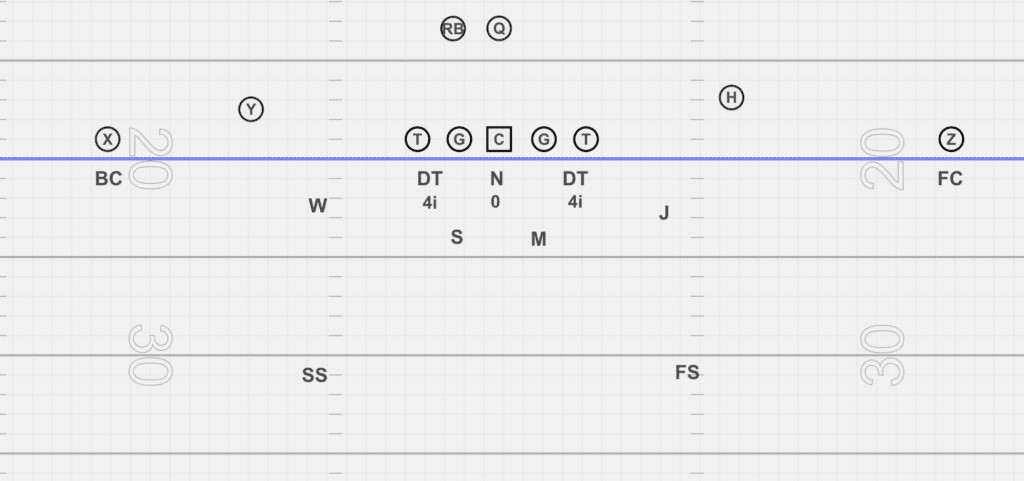The Tite Front is the defense’s answer to offenses that dominate the zone running game. This front naturally helps eliminate vertical-hitting B-gap runs.
The Tite Front uses three defense linemen: a nose tackle aligned in a 0 technique and two defensive tackles in two 4i techniques.
In this article, we’ll explain the Tite Front, how to install it, and its weaknesses.
Tite Front Structure
First, we will show you the structure of the Tite Front. But before you begin, it’s important to familiarize yourself with the techniques and alignments.
The Tite Front, also known as the Mint Front, has one nose tackle in a 0 technique. This means they are lined up directly in front of the center.
The other two defensive tackles line up on the inside shoulder of the offensive tackle, also known as a 4i technique.

The linebackers will line up directly over the guards, in 20 techniques.
On the outside, the outside linebackers (shown as the J and W) will line up in an apex alignment between the slot receiver and the end man on the line of scrimmage.
The goal of the Tite front is to spill the football to the sideline. This is done by the center taking one A Gap and the defensive linemen plugging the B gaps. This allows the linebackers to play A gap to C Gap, covering all gaps on the interior.
Nose Techniques
There are two techniques that your nose can play, in the 0 technique.
The first technique is an react-attack technique. This requires the nose to play in a 4-point stance and read the release of the center. The key is to keep the centers shoulders flat, so no holes can be open in the A-gap. Once the nose sees the ball declare, they can rip off and make a tackle.
The second technique is called a lag technique. The lag technique from a nose tackle is when the nose aggressively plays through the center. The nose will naturally fall into an open A gap, meaning the linebackers will take the other A-gap.
This is called a lag technique because the nose can’t be wrong. Regardless, they will fall into an A-gap. A lot of coaches will prefer to play this technique if they have a large, dominant nose tackle.
In our opinion, we like the lag technique because it allows for the nose tackle to play a bit more freely and aggressively rather than reacting to what the center does.
Why Play The Tite Front?
The Tite front is often played because it forces the ball to the sideline. This defense specializes in having players on the edges and to the outside, which can track down a running back that is forced to run outside.
The Tite front works well against zone schemes because it thins out double teams from the offensive line.
For example, if the offense is running inside the zone, they need to adjust their blocking scheme because they can’t just double the nose and go to the linebacker because they would vacate the B gap.
Against gap schemes, it puts a bit more pressure on the linebackers to spill the puller.
For example, if the offense gets counter, the play side linebacker needs to meet the puller in the hole and take him on to the inside. This will force the ball carrier to go outside, where the other linebacker can make the tackle. See our diagram below for a better visual.

If the linebacker is slow or doesn’t get to the inside of the pulling guard, it can cause some issues with gap schemes. Again, it takes some practice for linebackers to get good at this skill.
Weaknesses Of The Tite Front
The biggest with the Tite Front is the pass rush.
There are only 3 players rushing the passer, and they are all rushing from inside alignments. This means the two 4i techniques are at a disadvantage to the outside before the ball is snapped.

If you’re playing a mobile quarterback, the Tite Front is weak against setting the edge with a 3-man rush.
The next weakness of the Tite Front is against outside zone runs. It’s important that your 4i techniques play in a “react-attack” mindset so they can fight a reach block from the guard. If they go too fast upfield, there’s a good chance they will get reached or even trapped in a gap scheme.
If the defensive tackles are slow to get off the ball, they will get reached by the guard, meaning no hard edge is set. This can cause off tackle zone runs like wide zone and outside to hit for big yards.
Conclusion
The Tite front is great against 10 personnel. Against power sets, such as 11 or 10 personnel, it relies more on your outside linebackers and safeties to help fit the run.
If you want to learn more about defensive structure and position techniques, we recommend you check out our high school courses here.

